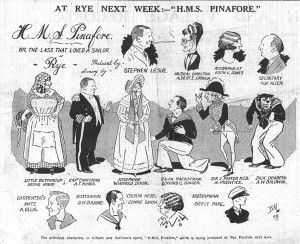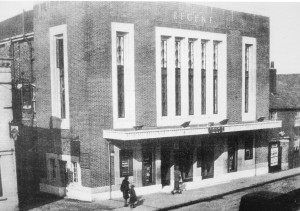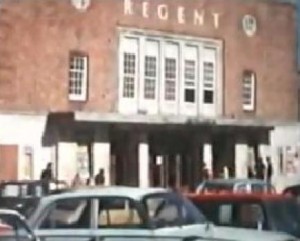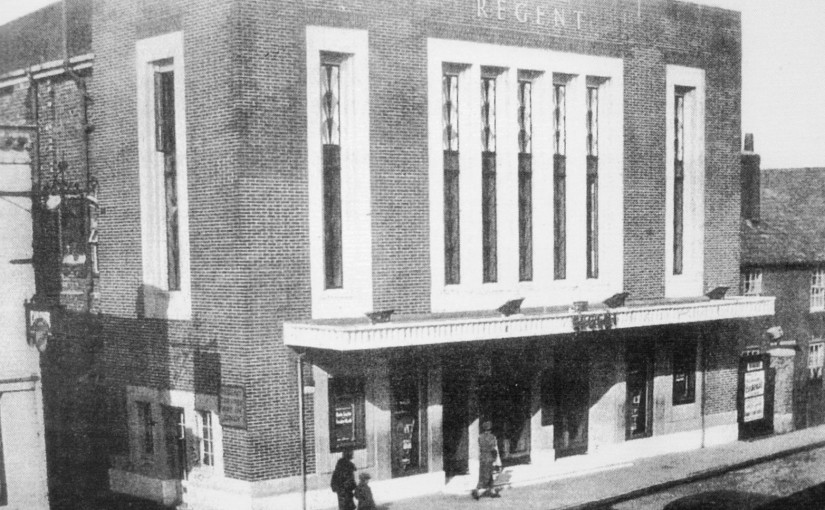By Arthur Woodgate
As one of the men who pulled the “Bijou” down I was urged by my own memories to put the story of the “Bijou” and other Cinque Ports Street buildings, as far as I can remember, into writing.
The “Bijou” real name was the “Cinque Ports Assembly Rooms” and during my memory most big meetings, gatherings, dances, concerts etc. were held in there, at the monastery or in the Church Hall at the rear of the Congregational Church (where the Rye Community Centre is today) . The Bijou was the better of the three, although they were all set out with an auditorium and stage, and were bigger than the present community hall with auditorium and stage. At the other two on Conduit Hill, the audience had to go upstairs to the theatre, but the “Bijou” was three steps up and the entrance was in line with the public pavement of the “Cinque Ports Hotel” which stood where the Police Station is now. The way into the market was between the building to the west of the hotel which was then the co-op. The Bijou adjoined the Inn and ran parallel with the road.
In 1930 the best of three entertainment halls was pulled down for room for even better. The new theatre was to take the same site, but square with the road and a bit bigger. Because it was close to the public path our hording and scaffold caused some inconvenience but we managed with no serious accident. I was appointed First Aider for the site but had little to do in that regard. Although there were chances taken which could have resulted in serious injury or even loss of life. An example was one in which I was involved. Along the road side part of were eaves but a big gable went up in the middle. The foreman had had this gable stripped out of any support, then another young bricklayer and I were told to climb up each side and pull it down, brick by brick. So, up we went but the higher we went, the greater the sway. We looked at each other over a point in the wall and we were as white in the face as snowmen. I said “don’t knock any bricks off Jim” “Go down carefully and I’m coming too”. We got down and found our foreman and told him that we refused to do that because it was too dangerous.. He brought in the General Foreman, who told us we were making a fuss for nothing and said he would go up and set off himself. Up he went but didn’t get as far as us before coming down and ordering a scaffold to be put round. My mate and I went and did something elsewhere laughing, if that gable had gone over, we would have both have been killed. My knowledge of first aid would have been lost to the site and my writings of Rye would too.

Ive got a bit more to say about the Regent Site before I talk about the rest of the street.
I have heard that political meetings were held in the Bijou, and it got very rough with chairs being thrown around. Connection to the Cinque Ports bar did not help. Travelling entertainers used to play there and I remember one such offered a big prize to anyone who could beat one of their number in a boxing bout. No one ever did, but it was entertaining.
In my scrapbook, I found a picture of cartoons drawn by A W Baldwin of the cast of Rye Actors for the 1929 show by “Rye Players” who called the “Bijou” “The Rye Pavilion”. This must have near been the last live show as we opened the Regent Cinema in 1932. Not much could have happened between then and 1929. The producer, Stephen Leslie and the musical director, Albert Crouch and accompanist, Edith Jones, would have all have been brought in but when we come to the secretary Guy Allen, he was the main Rye photographer for many years and would have taken pictures of almost everyone in the town over a period of many years. I have got some of the stages of my life taken by Guy Allen. He would have been a voluntary secretary of Rye Players, most of whom would have been amateur performers. In the 1929 production of the “Gilbert and Sullivan” opera. HMS Pinafore the cast pickers had Gilbert and Sullivan humour because they chose the largest lady for “Little Buttercup”, Bessie Hobbs of the Hobbs Family of Rye. “Hinds” had been importing timber on the strand for many years and in 1929 Bert Hinds was the head of the firm. He was also a wonderful amateur singer therefore that’s why he was chosen for Capt. Corcoran as the part has lots of singing. The characters next to Bert I don’t seem to remember but Dixons at Peasmarsh and the name of Ginger was heard about the area. Noel Prentice was a member of a Rye firm of lawyers (Dawes, Son and Prentice). He seemed to attend most social functions in the town. I now come to A.W. Baldwin. The man who drew all the characters on this publicity advertisement. A great artist who earned his living as a railway clerk at Rye Station. Mr Baldwin had a fun part himself as Dick Deadeye so he drew the fourteen leading actors in the production. Now, Arch Ellis is the second son of one of the founders of “Ellis Bros” Builders in Rye. He is a carpenter but in this opera he is the carpenter’s mate. He was able to sing pretty well too and that no doubt is why Mr Leslie wanted him in that part. Stan Braine, well known in Rye’s social life, but I don’t seem to remember what he did to earn a living. I also do not remember Connie Smith but, Cicely Pape, everyone around at that time would remember. Cicely was a teenager who could sing and dance. I was sixteen at the time and she made an impression on me. I knew her mother better as she was the outside clerk at Vidler’s Builders Merchants on the Strand.
There is a bit more about the Regent I must write. At the back of the then Cinque Ports Hotel and its off shoot there was a set out garden with stone ornaments dotted about. On the third day of our demolition, the ornaments were gone. We just thought the owner had moved them or sold them but the police came and started asking questions. Then they took one of our team, in his 40s, away for further questioning. At the police station they had found a police records of him having stolen a bike when in his teens. It seems he had an urgent message to take somewhere and seeing the said bike leaning against a wall, he borrowed it and having delivered the message, he put the bike back where he had found it. He was let go with a caution. Next day when we went to work, the ornaments were back where they had been. It wouldn’t have been possible for Sid to have moved them once, let alone twice, although he was a very strong man. It transpired that the owner moved them then so we could use the ground!

I have one more thing to say about the Regent site before I move on to say some more about the Cinque Ports Streets. I refer to the drawing on page 10 of the December 2012 issue of Ryes Own. When I turned to that page when it first came I had something of a shock. Its not the cinema we Rye lads built. I couldn’t at first see the pitched roof, but on closer look I could see a part of it over the auditorium. It was only the foyer with a flat roof the wall above the canopy in our Regent contained some ornamental brickwork. Mr Cousens, the architect, was so concerned about his appearance at the front that he came up on the scaffold and laid out bricks to show us what he wanted (not just big windows) but combination of brick red and plum coloured bricks, and he visited and looked quite often and stared at the front by standing at the other side of the main road. They were lovely bright red stock bricks with plum colour stocks in places. But the auditorium were plain fletons. The black and white drawing has done we Rye craftsmen a bad turn. It looks like some old (very old) barn with some of the bricks starting to get their face decaying because it was a Rye builder with nearly all of Rye’s construction operatives who built it.. We were stopped in the street and praised for a beautiful building Rye workers had produced, and we were so proud of it. By asking people what they remember and no one seems to call to mind that they can only remember the drawing, they never saw our work of art. Lots of them were not born, so I can confirm my own knowledge that the drawing was the second “Regent”. I keep forgetting how much older than them I am.
The Editor writes :-
The picture above is the one that Arthur is writing about – It was first published in “Rye’s Own” in the 1960’s and is has been used in two other publications, one by Ken Clark and the other by Alan Dickinson. Both caption it at the ‘Original Regent’. The first Regent was bombed in the War, and the Cinque Ports Hotel was very badly damaged. I only remember Regent One on the day it was bombed.

I have searched for a picture of the second Regent and found one on a David Smeed film. As can be seen Regent Two is very similar to the original but the window layout is different.
In my judgement the black and white photograph is the Regent that Arthur helped build but the poor quality of the picture printed in the December issue fails to portray the expertise of the craftsmen who built it. We have digitably improved the original picture so that the brickwork which Arthur is justly proud of, shows up better.
It now shows clearly that the Cinque Ports Hotel is still intact – not the postwar wreck that Ryers of my generation remember. (Editor)
From the April 2012 Issue of Rye’s Own
All articles, photographs and drawings on this web site are World Copyright Protected. No reproduction for publication without prior arrangement. © World Copyright 2015 Cinque Ports Magazines Rye Ltd., Guinea Hall Lodge Sellindge TN25 6EG
